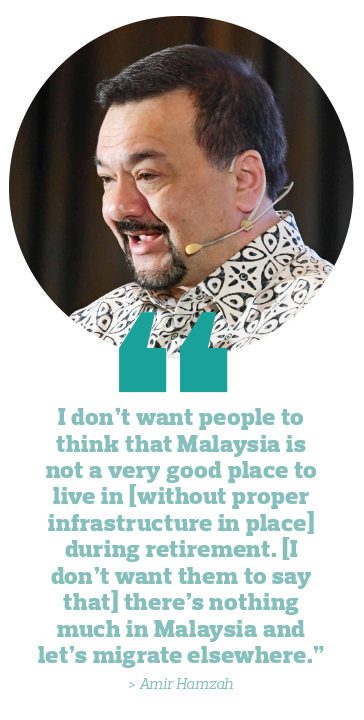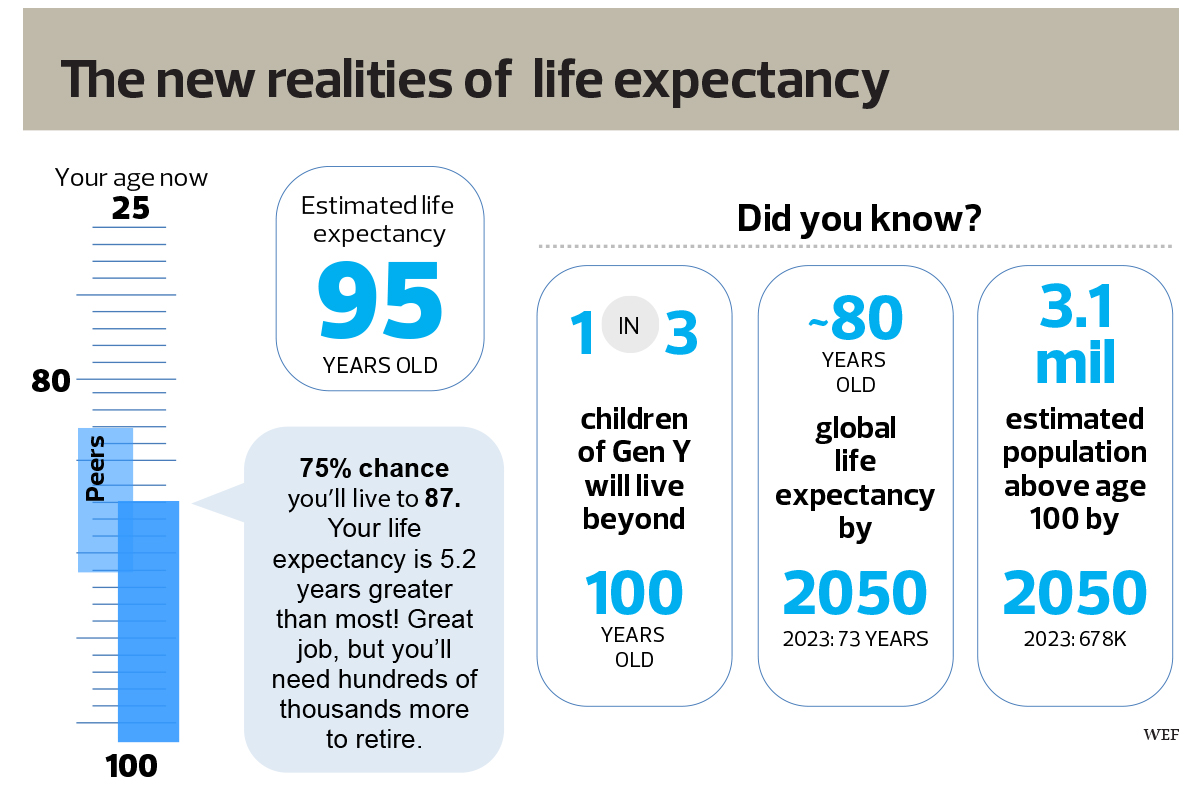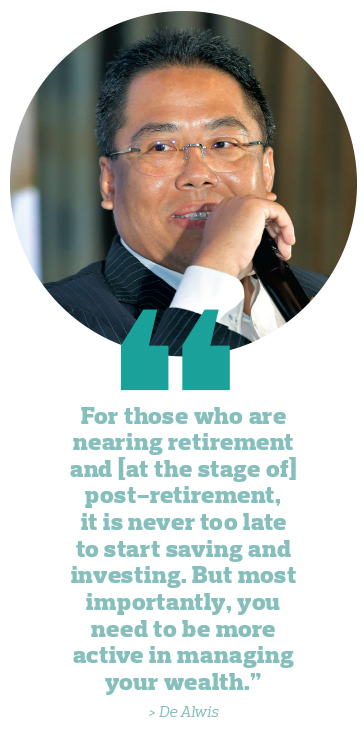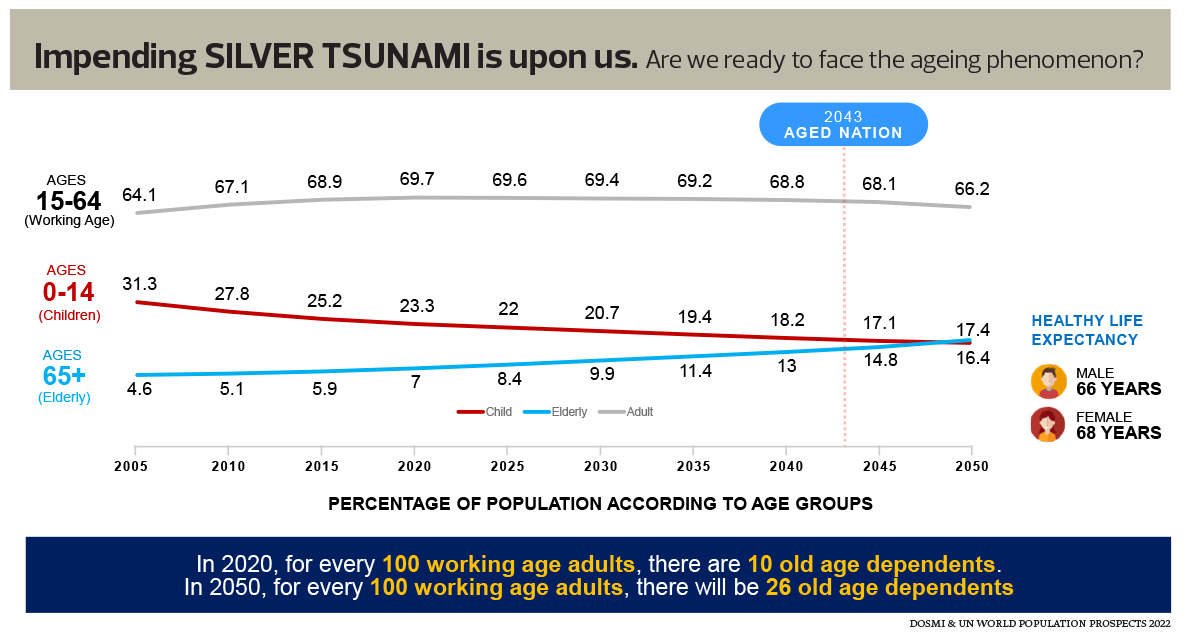
This article first appeared in Wealth, The Edge Malaysia Weekly on October 23, 2023 - October 29, 2023
Datuk Seri Amir Hamzah Azizan, CEO of the Employees Provident Fund (EPF), described the retirement landscape of the country as “worrying” and “dire”. The situation will only worsen in the next few decades if things stay the same, he said during his opening remarks and a fireside chat session at the The Edge Malaysia Retirement Reimagined Forum 2023.
Amir Hamzah said EPF is looking at several ways to help its members retire comfortably and with dignity. These include introducing a new mechanism for them to save and withdraw their retirement funds, and aligning their withdrawal age with the country’s minimum retirement age.
The new mechanism will include a flexible account from which its members can withdraw funds at any time, especially in times of emergency, according to a recent announcement made by Amir Hamzah.
EPF members are now allowed to partially or fully withdraw their retirement funds at 55 years old. As many exhaust their funds in five years, they are left with little to no money for retirement when they cease to have an active income after stopping work at 60 years old.
On the flip side, EPF members would have a much larger nest egg to rely on if they were to leave their savings untouched for a few more years. For instance, individuals earning a minimum wage of RM1,500, with an annual salary increment of 3%, would have RM479,000 in their EPF accounts when they retire. The amount would be RM665,000 and RM909,000 if the withdrawal were deferred by another five and 10 years respectively.
Interestingly, EPF is investing in turning its old headquarters located in Jalan Gasing, Petaling Jaya, into an aged care centre. While Amir Hamzah did not elaborate on how it would work, he said it was part of the provident fund’s efforts to better prepare the country for its transition to an aged nation.
“We are trying to create our first aged care centre in Jalan Gasing, [where our] old headquarters was situated. We are trying to work with the operator to get aged care facilities. When we get fair returns, we will create more facilities along the way,” he said.
By 2044, at least 14% of the country’s population will be aged 65 and above. Twelve years after that, at least one in every five Malaysians will be a member of the silver-haired club, according to the World Bank.
The World Bank’s projection is in line with that of the Department of Statistics Malaysia (DoSM). The agency projected that 5.1 million, or 13.01% of the country’s population, will be aged 70 and above by 2040. By 2057, 9.5 million (or 22.6%) of the 42 million Malaysians will be aged 70 and above.
On investments, Amir Hamzah said EPF has always been a major investor in the nation’s various infrastructure projects. A classic example is the PLUS highway that has spurred mobility and tremendous economic growth.
In the healthcare sector, EPF is an investor in IHH Healthcare Bhd, which owns one of the world’s largest healthcare networks with 83 hospitals in 10 countries, including Malaysia, Singapore, Turkey and India. The retirement savings fund also has a stake in KPJ Healthcare Bhd, another well-known company and brand to Malaysians.
“But now, at EPF, what we are trying to do is that we are pushing the envelope further … we are looking at where we are able to invest in infrastructure that will help our members live a better life when they retire, such as aged care centres, so that the social economic impact is bigger to the nation and its people,” said Amir Hamzah.
After all, money and returns are only part of the equation for a comfortable and dignified retirement. “I don’t want people to think that Malaysia is not a very good place to live in [without proper infrastructure in place] during retirement. [I don’t want them to say that] there’s nothing much in Malaysia and let’s migrate elsewhere. I want people to feel that they have enough and also have everything they need here,” he said.
However, investments made by EPF in aged care-related infrastructure come with expectations of fair returns — they are not given out in the form of subsidies, he emphasised.
Vulnerability seen in current elderly population, informal sector
With assets of more than RM1 trillion, EPF is one of the largest retirement savings funds globally. It was ranked No 23 out of 44 retirement income systems by the Mercer CFA Institute Global Pension Index last year, putting it ahead of pension systems in some developed nations, including China, Japan, South Korea and Taiwan.
Scored 63.1 by the report, EPF ranked higher than most of its peers in Asean such as Indonesia (49.2), the Philippines (42) and Thailand (41.7), with the highest ranked in Singapore (74.1).
Yet, despite the good work of EPF over the past decades, there are clear signs that things need to change.
There are currently 3.6 million Malaysians aged 60 and above. Among them, 2.6 million (73%) are not protected by any pension programme, while only 125,000 (3%) have savings of more than RM240,000, which translates into just RM1,000 per month for the next 20 years.
Also, 140,000 (4%) of the 3.6 million elderly population fall into the hardcore poor category and rely on Bantuan Warga Emas (a financial assistance programme provided by the government through the Department of Social Welfare) to survive.
While many among the elderly population are already struggling to take care of themselves, they also need to take care of their families.
EPF statistics show that out of the 8.2 million households locally, 793,000 (9.7%) are headed by the elderly. A total of 325,000 of them fall under the relative poverty category, defined as households that make 50% of the median household income of the nation.
The median household income of the country in 2020 was RM5,209 per month. Half of that amount would translate into RM2,604 per household per month.
At the same time, 95,000 (12%) out of the 793,000 households led by the elderly fall under the category of absolute poverty, where each household earns less than RM2,208 per month.
If one assumes that EPF savings are the only source of income for the elderly, then many of them are clearly struggling to retire.
Amir Hamzah pointed out that about 40% of the labour force in Malaysia are not covered by any formal legislation for pensions and retirement, in particular those in the informal sector.
Based on EPF statistics, the country has an employed labour force of 16.3 million, with four million of them working in the informal sector. The definition of informal sector, according to the provident fund, is informal employment that lacks formal coverage for pension or retirement income.
Hence, one of EPF’s priorities is to onboard employed workers in the informal sector, said Amir Hamzah. “We want to facilitate the EPF scheme to cover the informal sector and bring them on board, which is very fundamental, so that more people can get better social protection in Malaysia. I’m grateful that the government is also providing incentives for people in the informal sector to do their fair share [to save for their retirement].”
Retirement is a structural issue
However, the public should understand that retirement is a complex issue that involves not just EPF, but also the government, the country’s economy and the behaviour of the people. For instance, the main reason for the lack of retirement savings is the country’s low wage structure. When one earns less, he or she also has less to save for retirement.
EPF statistics show that 79% of its members earn less than RM5,000 a month. Of this number, 61% earn less than RM3,000 a month and 41% earn less than RM2,000 a month.
Hence, EPF is supportive of the implementation of the minimum wage policy by the government. “The government is pushing wages up to an acceptable level. We are encouraged by this. However, not only wages, labour productivity has to go up to enable higher payments too. EPF is quite a strong supporter of this,” said Amir Hamzah.
Malaysians, both young and old, need to take ownership of the retirement challenges that they and the country are facing, he added. “Ultimately, the key to retirement is that the challenges belong to us. We have to take ownership. We also contribute to those challenges.
“This is why EPF is stepping up our game to use our technology to facilitate good financial behaviour for people to save for retirement. You’ve got to do that. And we are making our products and services easier for you to top up.”
Active portfolio management and new asset classes
Datuk Wira Ismitz Matthew De Alwis, CEO of Kenanga Investors Bhd, touched on the need for the elderly to manage their portfolios more actively and how technology can benefit fund managers in generating better returns for their clients.
The rule of thumb to enjoy a good retirement is to start saving from a young age. “Please forgive me for sounding like an old record player. We should always start saving and investing when we are young. But doing that is always a challenge when you look at one’s disposable income,” he said.
De Alwis resonates with Amir Hamzah’s view that retirement is a complex issue that cannot be solved by just one party. “The issue is also wages. How much one earns, and what’s the disposable income they have for them to save for retirement is very important,” he added.
As for those who are nearing retirement or have retired, De Alwis’ advice to them is to manage their portfolio more actively, as they do not have the luxury of time to invest over the long term like the younger generation.
“For those who are nearing retirement and [at the stage of] post-retirement, it is never too late to start saving and investing. But most importantly, you need to be more active in managing your wealth,” he said.
“You need to enhance your financial literacy, keep an eye on market news and economic issues, and rebalance your portfolio very actively as compared to when you were in your thirties or forties when you could still invest with a long-term view.”
Yet, to achieve a comfortable and fulfilling retirement also requires one to study and engage in different products and services. Other than investment products, they should also look at insurance policies, healthcare and aged care facilities and services should the need arise.
“It’s not just about money. You also have to look at the other parts of the [retirement] ecosystem. You also need to look into buying a health and medical insurance policy when you’re young. Don’t wait until you’re in your thirties or forties. It gets more expensive,” said De Alwis.
“It is also important to look at healthcare services. And whether you have enough for these post-retirement.”
On whether technology has helped improve the financial well-being of Malaysians, De Alwis said access to personal loans and credit is increasing as technology advances. This can be seen in the emergence of buy now, pay later (BNPL) services, where a person can purchase various items via a 0% instalment plan. The catch is that late payment fees are imposed if they overspend and fail to make repayments.
Personal loans that come with higher interest rates are also easily accessible now through mobile applications such as the Touch ‘n Go app.
According to EPF statistics, many Malaysian households are already taking on more debt than they should, with the household debt-to-income ratio at 146%.
On top of that, it found that 47% of youth have high credit card debt. The younger generation could struggle decades down the road if they are unable to save for their retirement early on.
De Alwis said that from the perspective of a fund manager, the emergence of new financial products and services like BNPL present an opportunity for Kenanga to generate better returns for its investors.
“From the investment point of view, technology has created different asset classes other than the traditional ones like equities and bonds. There are things like BNPL and Bitcoin or cryptocurrencies. There have been ongoing developments in these asset classes, but yes, they are still very new.
“For fund managers like us, do we look at them? Yes. Do we invest in them? Maybe. These are new asset classes,” he continued.
“If someone asks me later if I will use it? I may not. But the younger generation would. They provide us with the opportunity to provide funding and get higher yields [for our investors]. So that’s another perspective.”
Should retirees look at these asset classes? De Alwis said it depends on their risk appetite and the life stage they are in. “If you’re nearing retirement or post-retirement, no. But if you’re a youngster, you may want to look at them as they provide you with different opportunities,” he added.
EPF to explore investing in new geographies and further diversification
During the Q&A session, a participant asked how EPF weathers the market volatility that is so commonplace these days. Another participant asked if EPF can benchmark its returns on a real return basis, instead of nominal return.
Responding to the first question, Amir Hamzah said EPF adopts the Strategic Asset Allocation (SAA) investment approach that has proved to be successful in helping the provident fund ride out various economic cycles.
The investment strategy protects the downside of its investment portfolio through diversification and seizes market opportunities when the market swings back up by providing its fund managers with flexibility.
Amir Hamzah said EPF’s portfolio invests about 45% of its members’ money in fixed income, 37% in equities and the rest in inflation protection asset classes such as infrastructure and real estate.
“The SAA is signed off by the Ministry of Finance, and we operate based on it. It’s proved that during up or down cycles [the portfolio does well]. It is a balanced and diversified portfolio. We also give our fund managers the flexibility to take opportunities in the market,” he added.
“The Covid-19 pandemic was a difficult period. Yet, EPF was relatively resilient. Yes, the dividend rate was lower, but it far outpaced many managers in that environment. [The protection mechanism] was designed into our SAA approach. The discipline of the EPF team to operate within the given parameters also provides stability to our portfolio.
“What we want to do is to further diversify our portfolio … We may be exploring new geographic and asset classes. But underpinning it, we must have the capability to do so. And for this, we will either put more technology in place or bring in more partners who are capable in those areas. Over time, we will build up that capability [to invest]. This model has been proved historically and has helped us make our portfolio more resilient.”
As for the second question, Amir Hamzah said EPF sets its return target based on real return rates, and not on a nominal basis. The provident fund uses the Malaysian Government Securities (MGS) rates as a benchmark and adjusts its returns for inflation to derive its minimum return rate.
“Historically, EPF has delivered the numbers and the reality is that we have outperformed much of the market. So, it depends on which benchmark you use. If you use a global, dollar-based benchmark [for EPF portfolio performance and shield it from the depreciating ringgit], then our portfolio must lean towards a global portfolio [that invests in US dollars]. However, our portfolio uses a local benchmark,” he said.
Save by subscribing to us for your print and/or digital copy.
P/S: The Edge is also available on Apple's App Store and Android's Google Play.
- Gas pipeline blaze: MIDF flags potential RM18m impact to Petronas Gas
- Gas pipeline blaze: Petronas Gas, Gas Malaysia’s shares open marginally lower after trading halt
- T7 Global drops to two-year low, triggers short-selling halt after deputy chairman's departure
- Digital banks in Malaysia urged to re-examine strategies to better serve B40 segment
- Yinson's shares slip, analysts tell investors to look past underwhelming results
- CIMB, Bank Islam, Etiqa to assist Putra Heights fire incident victims
- China curtails more renewables as record additions stress grid
- US tariffs expected to affect Asia Pacific economic growth – S&P Global
- SC Annual Report 2024: SC swings to RM20.7 mil operating surplus, recovering from largest deficit in a decade in 2023
- SC Annual Report 2024: Malaysia’s capital market outperforms regional peers, funds raised hit RM138.9 bil in 2024




